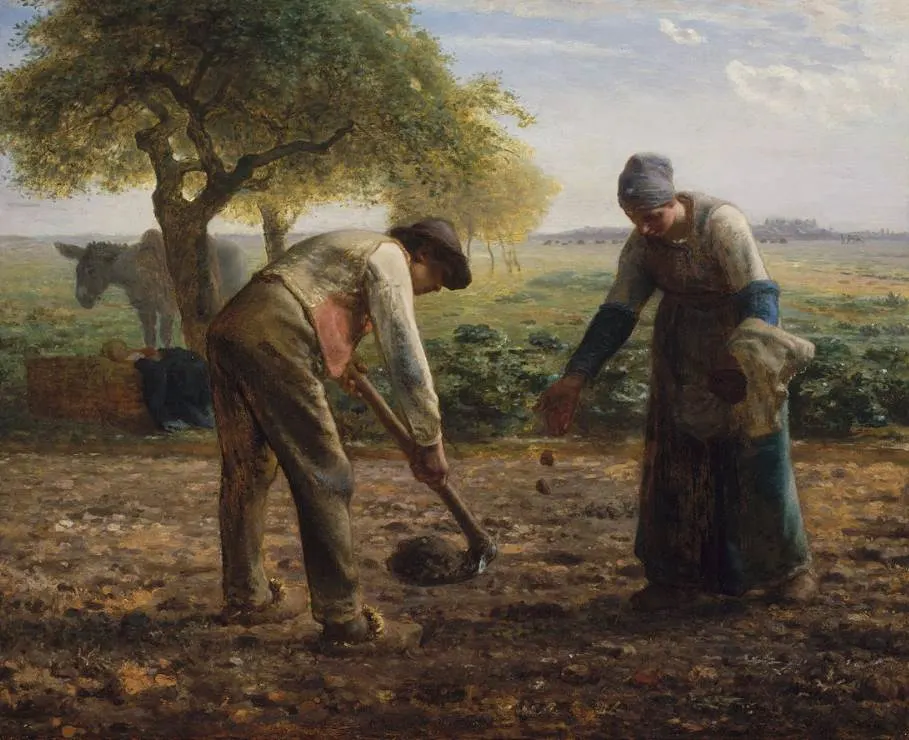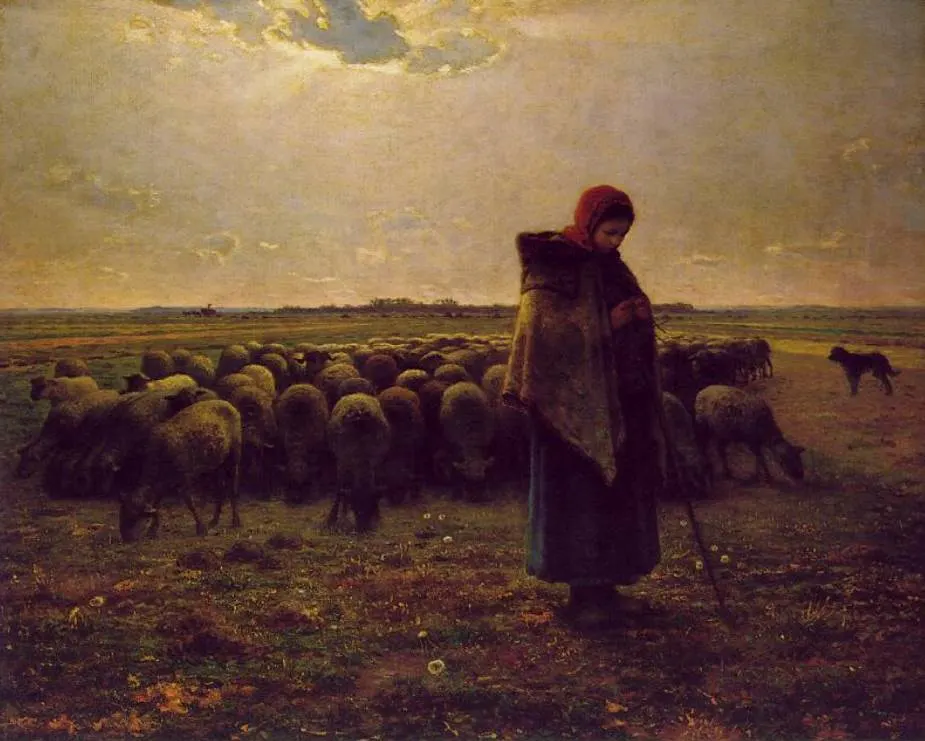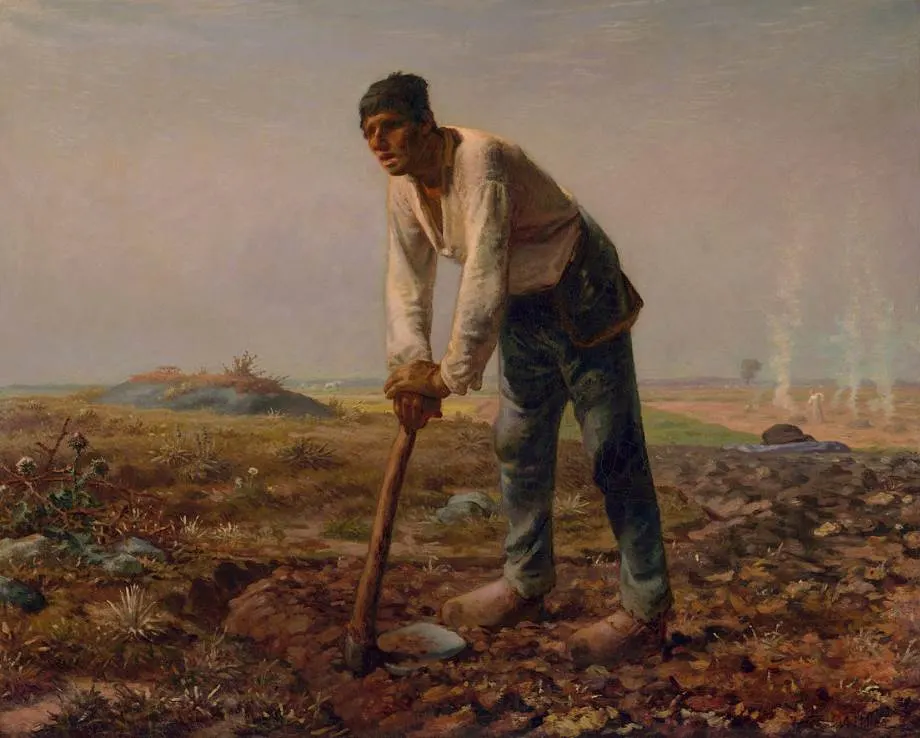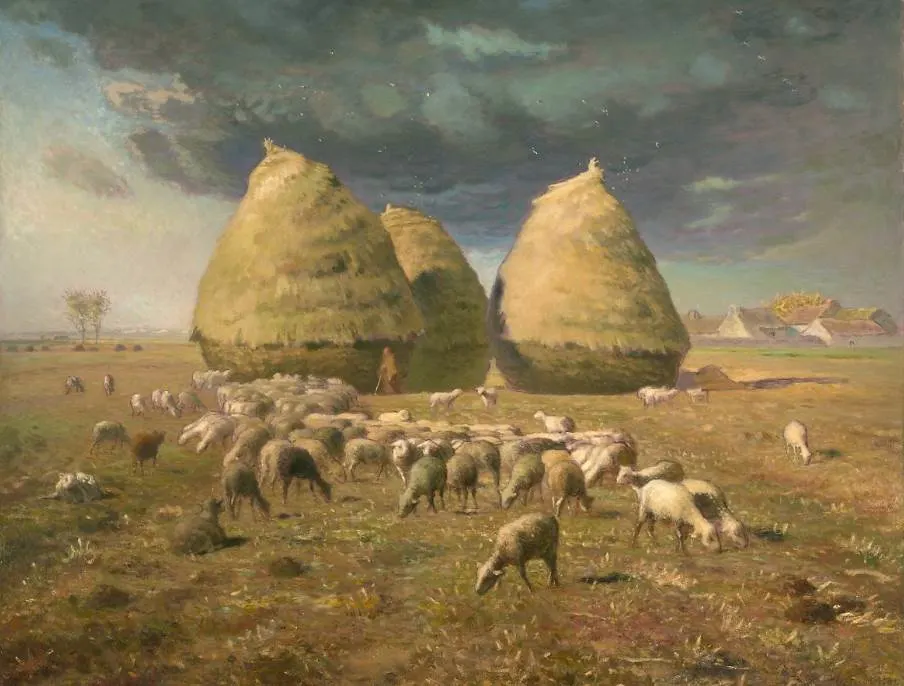This French artist grew up in the countryside of the Normandy region of France. Although he lived in Paris for several years, his career flourished when he moved back to the French countryside.
Jean-François Millet (1814-1875) was a Realism artist and one of the founding fathers of the Barbizon school of painting.
This art movement was named after the town of Barbizon where Millet settled. Here he depicted realistic views of the countryside and local peasants.
His reputation gradually grew and he became one of the most sought-after artists in France starting in the 1860s, producing numerous iconic Realism paintings in the process.
He earned the Chevalier de la Légion d’Honneur, the highest order of merit in France, and was elected as a member of the jury of the Paris Salon in 1870.
In this article, you’ll discover some of the most famous paintings by Jean-François Millet so you can learn all about this important 19th-century artist.
1. The Gleaners
- Date created: 1857
- Dimensions: 83.8 × 111.8 centimeters (33 × 44 inches)
- Location: Musée d’Orsay, Paris, France
The Gleaners isn’t just one of the most famous artworks of the Barbizon School, it’s also one of the icons of the Realism art movement. It depicts a group of omen “gleaning”, which means picking up the leftovers of wheat after the harvest.
This type of work was considered to be one of the lowest forms of labor. It was therefore seen as an attempt to glorify the working class in society, which made the upper class rather angry. Millet was even classified as a socialist, and although he certainly held the working class in high regard, he wasn’t a hardcore socialist like his colleague Gustave Courbet (1819-1877).

2. The Angelus
- Date created: 1857-1859
- Dimensions: 55.5 × 66 centimeters (21.9 x 26 inches)
- Location: Musée d’Orsay, Paris, France
The Angelus is another painting by Jean-François Millet that was interpreted the wrong way in the late 1850s. It depicts a couple of peasants who are saying the Angelus, a form of Christian devotion. The church in the distance was reminiscent of Milet’s childhood years when the artist’s grandmother said a similar prayer.

The identity of the two figures and their relationship remains unknown. It could be a couple of married peasants, but a farmer and his female servants have also been suggested. Despite initially being classified as a socialist painting, it became one of the most reproduced religious works of art in the second half of the 19th century.

3. The Potato Planters
- Date created: 1861
- Dimensions: 82.5 x 101.3 centimeters (32.48 x 39.88 inches)
- Location: Museum of Fine Arts, Boston, United States
The Potato Planters is another painting that depicts two farmers while they are planting potatoes in a field near the French town of Barbizon. While this might seem like a normal job for two farmers, potatoes weren’t considered to be a very enjoyable type of food to eat in the 19th century.
The negative connotation of potatoes was a reference to poverty. Here we can see two peasants who are planting potatoes so they could death them themselves. The same reference can be seen in one of van Gogh’s famous paintings titled “The Potato Eaters” (1885). Vincent van Gogh (1853-1890) was a great admirer of Millet and was inspired by his paintings that depict peasants.

4. The Potato Harvest
- Date created: 1855
- Dimensions: 54 × 65.2 centimeters (21 × 25.7 inches)
- Location: Walters Art Museum, Baltimore, United States
The Potato Harvest is a painting of the same subject, except that it depicts the harvest of potatoes by the farmers in the area of Barbizon. Millet had a great relationship with farmers because he grew up in the rural areas of Normandy in the northwestern part of France.
Although he lived in a rural area near Paris at the time, he also included elements that were drawn from memories of his childhood. The general theme of these paintings was the struggle for survival of the common peasants who had to dig a hole in the ground to find food to eat.

5. Hunting Birds at Night
- Date created: 1874
- Dimensions: 74 x 93 centimeters (29.1 x 36.6 inches)
- Location: Philadelphia Museum of Art, Philadelphia, United States
Hunting Birds at Night is a painting by Jean-François Millet that is also known as “Bird’s-Nesters.” It depicts a rather horrible scene of peasants chasing pigeons that are sitting in trees at night and beating them to death with clubs. They do so after blinding the birds with torches.
Unlike many of his other paintings, this one was painted solely from his imagination. He was told the story of huge flocks of pigeons resting in trees during his childhood years and he based this painting on what he remembered of it.

6. Shepherdess with Her Flock
- Date created:
- Dimensions: 81 x 101 centimeters (31.8 x 39.7 inches)
- Location: Musée d’Orsay, Paris, France
Shepherdess with Her Flock is a painting by Millet that depicts the common subject of a shepherdess who is roaming around a field with her sheep. It was a subject that Millet was very interested in and he carefully planned painting this work, starting in1862 and only completing it in 1864.
It’s one of the paintings that he displayed at the Paris Salon of 1864 and it became one of his greatest triumphs at this prestigious event in the world of art. The middle class of France thoroughly enjoyed the idealized version of peasant life, which was in sheer contrast with the hardship of farmers he depicted earlier in his career.

7. Harvesters Resting
- Date created: 1851-1853
- Dimensions: 67.3 x 119.7 centimeters (26.4 x 47.1 inches)
- Location: Museum of Fine Arts, Boston, United States
Harvesters Resting can be described as one of the most ambiguous paintings by Jean-François Millet. That’s mainly because he depicted common peasants who are resting during a harvest session while trying to integrate the Biblical story of Ruth and Boaz into it.
Ruth and Boaz was the original title of the painting as it refers to the Biblical story of Ruth. According to the Bible, she was a poor woman who had to support herself by picking up leftovers after the harvesters had finished. Millet aimed to stress her hardship by depicting the small stack she is holding which is in sheer contrast to the huge stacks collected by the harvesters.

8. The Goose Girl
- Date created: 1863
- Dimensions: 38 x 46.5 centimeters (14.9 x 18.3 inches)
- Location: Walters Art Museum, Baltimore, United States
The Goose Girl is a painting that was MIllet’s attempt to depict the idealized female nude body in a natural setting. This had been done since the Renaissance and the French Realism artist aimed to depict a similar scene from the perspective of Realism art.
The kerchief and rough hands and feet identify the young girl as a peasant who just worked in the field. She is about to enjoy a bath after a hard day of work in the blistering sun. Millet completed this painting in 1863 but already started making preparatory drawings 7 years earlier.

9. The Winnower
- Date created: 1847-1848
- Dimensions: 100.5 × 71 centimeters (39.6 × 28 inches)
- Location: National Gallery, London, United Kingdom
The Winnower is the title of three very similar oil on canvas Millet paintings. What’s remarkable about this work is that it was the first attempt by Millet to paint peasants from real life. The first version was completed in 1848, a year before he settled in Barbizon to become the founder of the Barbizon School.
The first in this series of three paintings that depict a winnower is much larger than the second and third versions and was presented at the Paris Salon of 1848. His monumental painting titled “The Captivity of the Jews in Babylon” was hammered by art critics but this work was acquired by eh French state. He probably destroyed the criticized painting and solely focused on depicting peasants shortly after.

10. The Man with the Hoe
- Date created: 1860-1862
- Dimensions: 80 x 99.1 centimeters (41.4 x 39 inches)
- Location: Getty Museum, Los Angeles, United States
The Man with the Hoe is the title of a Millet painting that depicts a peasant doing hard labor in a field. It inspired a poem by an American poet named Edwin Markham who presented his poem with the same name on New Year’s Eve, 1898.
The painting was interpreted as a socialist protest against the hardship of the common worker in France in the mid-19th century. The poem conveys a similar message as it starts as follows:
The Man with the Hoe
Bowed by the weight of centuries he leans
Upon his hoe and gazes on the ground,
The emptiness of ages in his face,
And on his back the burden of the world.

11. Haystacks: Autumn
- Date created: 1874
- Dimensions: 85.1 × 110.2 centimeters (33.5 × 43.4 inches)
- Location: MET Museum, New York City, United States
Haystacks: Autumn is the title of a painting that depicts just that, massive haystacks lying around in a French field near Barbizon. It’s one of four paintings of the four seasons that were commissioned in 1868 by a French industrialist named Frédéric Hartmann.
Because of the Franco-Prussian War in the early 1870s, it took until 1874 before he completed this Autumn scene. It was also one of the final paintings that he worked on because Jean-François Millet passed away in January of 1875 at the age of 60.

